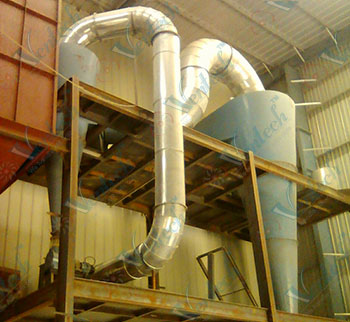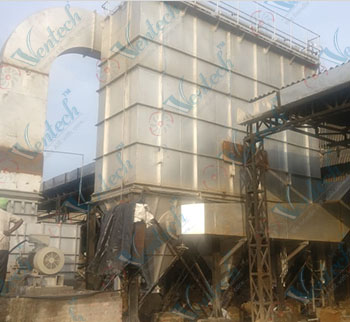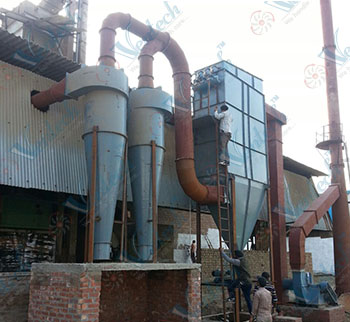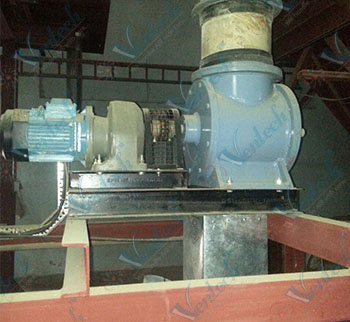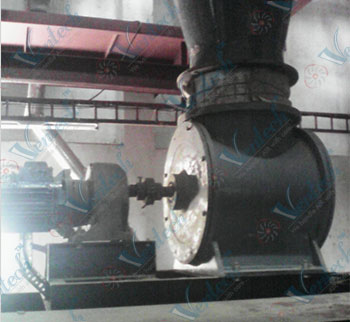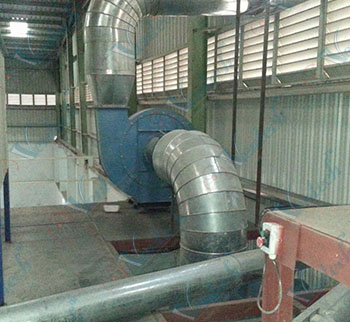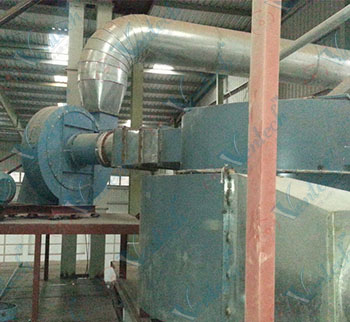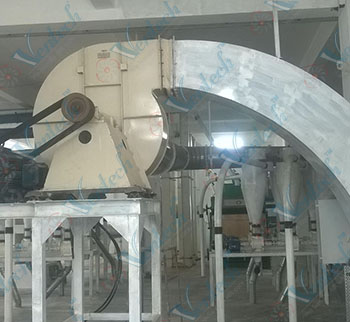Dust extraction and collection form a very important part of Industrial Air Pollution Control. Modern industrial practice demands an environment that is safe and hygienic for all mankind. As a country develops its infrastructure,its technical resources expand bringing both benefits and commitments to its industries. Responsible engineers and government must ensure that proper consideration and effective action is taken to protect the atmosphere from industrial pollution. Because of all the above facts, Dust Extraction and Collection play a very important role in any type of industry whether it is a huge Steel plant, a Coal handling plant, a Cement plant, a medium scale industry or for that matter, even a very small scale factory.
Air cleaning devices remove contaminants from an air or gas stream. They are available in a wide range of designs to meet variation in air cleaning requirements. Degree of removal required, quantity and characteristics of the contaminant to be removed and conditions of the air or gas stream will all have a bearing on the device selected for any given application. Air cleaning devices are divided into two basic groups : AIR FILTERS and DUST COLLECTORS. Air filters are designed to remove dust concentrations of the order found in outside air and are employed in ventilation , air conditioning and heating systems where dust loading is just nominal. Dust collectors are usually designed for the much heavier loads from industrial processes where the air or gas to be cleaned originates in local exhaust systems or process stacks gas effluents. Loadings will vary from 5 to 10gm/m³ and onwards. Therefore, concentrations in dust collectors are some 100 to 20,000 times greater than that for which air filters are designed. Degree of collection required can depend on plant location; comparison of quantities of material released to atmosphere with different types of collection; nature of contaminant – its salvage value or its potential as a health hazard, public nuisance or ability to damage property – and the requirements of the local or state air pollution regulations. One safe recommendation in equipment selection can be summed up as : select the collector that will allow the least possible amount of contaminant to escape and still be reasonable in first cost and maintenance as well as meet all prevailing air pollution regulations. For some applications, even the question of reasonable cost and maintenance must be sacrificed to meet established standards for air pollution control or to prevent damage to health or property.
Dust extraction systems have six basic components:
- Dust extraction systems have six basic components:
- 1. The hood or the entry point of the system.
- 2. The ducting system which conveys or transports the captured dust.
- 3. The air cleaning device, which removes contaminants from the dirty air stream.
- 4. The air moving device provides the necessary suction for capturing and transporting the dust to the air cleaning device.
- 5. The dust disposal i.e. the disposal of the dust which has been effectively captured & collected.
- 6. The Stack
Let us now analyse each of the aforesaid components one by one.
A. Hoods :
- The hood design should be such that all the air borne contaminant enter the hood and there is no escape of dust particles outside the hood area. The effective control of a contaminant producing process is brought about by first eliminating or minimising all air motion near the process and then capturing the contaminated air by causing it to flow into the exhaust hood. For this condition to be achieved, a proper capture velocity is to be selected. Air flow towards the suction opening must be sufficiently high to maintain the necessary capture velocity at the hood face and to overcome the opposing air currents. Elimination of sources of air motion as a first step in hood design is an important factor in cutting down the required air volume and power consumption of Blower horse power. The most effective hood uses the minimum exhaust volumetric flow rate to provide maximum contaminant control. Knowledge of the process or operation and generation pattern of the dust is very much essential before a hood can be designed.
- Hoods can be of two types namely (a) enclosing hoods and (b) non-enclosing hood. Enclosing hoods provide better and more economical contaminant control because the exhaust rate is not effected by cross draft/current in the department. Enclosing type of hoods are normally found in conveyor systems where the transfer point is totally enclosed and a slight draft across the front opening directs the dust into the hood. To select adequate air flow rate to draw the dust into the hood, a certain capture velocity is required. The capture velocity may vary between 0.25 m/sec to 10 m/sec.
- Care should also be taken to see that the hood is placed as close as possible to source of dust without affecting the operation of the machinery or tool.
B. Ducting System:
- The ducting system plays a very important part of a dust collection system, because once the contaminant is effectively captured it has to be properly transported to the cleaning device without polluting the other areas. The design of the ducting system is based on the minimum transport velocity to be maintained so that the dust does not settle in the inside duct surface. The material of the duct is decided based on the abrasive and corrosive nature of the dust. Normally MS sheets of 1.6 mm to 5 mm are used for duct fabrication. When dust extraction system is designed for a abrasive dust like coal, cement or ceramic dust, bends & Y pieces are generally fabricated out of higher thickness sheets for longer life. For a fairly large dust extraction system, proper clean out doors shall be provided as adequate intervals for purpose of easy cleaning and maintenance. Moreover bends should be designed to have large radius (wherever possible) and Y branches should have minimum angle of entry for reducing the pressure drop in the system. Excessively high velocity in the ducting system will result in higher pressure drop in the system and consequently higher power consumption. Moreover higher velocities may cause rapid abrasion of duct work.
C. Cleaning device:
- Selection of proper air cleaning device depends on the following factors:
- 1. Concentration & particle size of contaminant.
- 2. Degree of collection required.
- 3. Characteristic of the contaminant (if there is fire hazard, wet systems are recommended).
- 4. Method of disposal.
Once the contaminant is captured & transported the objective is not achieved unless the air contaminated with dust is cleaned. There are many types of air cleaning devices which cleans the air and separates the dust particles from the contaminated air stream. Some of the air cleaning devices are:
- 1. Low ratio shake type bag filter
- 2. Pulse jet type fabric filter.
- 3. High efficiency venturi scrubbers.
- 4. Electro static precipitation
- 5. Multi Clones
- 6. High efficiency Cyclones
- 7. Low efficiency Cyclones.
- 8. Unit type wet and dry type Dust Collectors.
D. Air Moving Device:
- Having designed a suitable hood and dust collector, a suitable exhaust fan or blower is required to create the necessary suction at the hoods. The capacity of the fan selected based on the total volume of air quantity required at various suction points of the system and a factor (normally) 10% of the theoretical volume is added to take care of possible leaks in the ducting system. Having designed the air quantity, the pressure drop in the system (i.e. the resistance in the system that the fan is to overcome) is calculated. The factors that constitute the pressure drop calculation are as follows:
- 1. Hood entry loss
- 2. Duct loss (straight duct + Bends etc.)
- 3. Dust cleaning device pressure drop
- 4. Exhaust / chimney loss
- 4. Weather cowl loss.
Proper hood design is to be made keeping the entry loss minimum and the bends Y’s should have good radius & entry angle to reduce the pressure drop.
A very important factor for designing the exhaust chimney in stock is to see that there are no exhaust cowls in the stock. Exhaust cowls have a tendency to deflect the air downwards increasing the chances of contaminating the working areas. Exhaust cowls also create friction loss.
Hence for any type of dust extraction system it is advisable to use stack hoods whereby the velocity of the outgoing air is reduced to only 50% of the original velocity at 12 times the stack diameter. Hence the effective stack height is quite high compared to the physical height of the stack. Water entry into the stack and thereby into the fan can be avoided by making the air enter the stack at an angle. It would be of interest to note that in big industrial undertaking like Cement, Coal, Thermal power plant etc. the minimum stack height is normally 30 to 40 meters even though the outlet emission is required to be limited to a safe working level of 150 mg/m3. This is only to take care in case there is some problem with the dust cleaning device, thereby the outlet emission going higher, but due to the stack height gets diluted in the atmosphere.
E. Dust Disposal System:
The objective of a Dust Extraction system is not fulfilled unless the hazardous dust or contaminated dust that is filtered or removed from the dirty air stream is disposed in a proper manner without creating a secondary dust nuisance problem. Dry materials can create a secondary dust problem. In wet collectors, secondary dust problems are eliminated, although disposal of wet sludge can be a material handling problem. Solids carryover in waste water can create a sewer or water pollution problem. There are various types of dust disposal methods. In a wet system, the disposal of dust is simple, since the dust mixes with water and forms a slurrywhich can be let into a separate drain. If it is a dry dust like Cement, Coal and Ceramic dust, it is better to discharge the collected dust into the same conveyor from which it is extracted. If you take a case of brake lining out of asbestos, the dust collected in the bins at the bottom of the dust collection are mixed in a concrete mixed with water and the dust from a semisolid which is dumped into a pit which is covered later.
The other form of disposal system in dry application is to transport the collected dust into a bucket elevator and then transfer the dust into a storage silo. At the bottom of the silo there is a rotary air valve which will empty the contents into a closed dumper.
A relatively new concept is the use of insertible type dust collector (vent type) dust collector in the hood itself so that the dust is again dislodged into the same conveyor or silo. These types of dust collector are mostly used in conveyor transfer points and silos.
It is imperative to note that the objective of the system is to be properly defined and care shall be taken to specify that the system is intended only to extract the AIR BORNE dust. People have a wrong notion that a Dust Collector performs the function of a vacuum cleaning system whereby they expect that the dust collector will take care of the spillages etc. of the dust particles due to handling etc. The other aspect is to specify the guaranteed parameters like outlet emission subject to specified inlet dust condition. Another important aspect is to clearly specify the limitations in the design of Hood and placement of hood due to working conditions of tool etc. which will in turn affect the collection of dust.

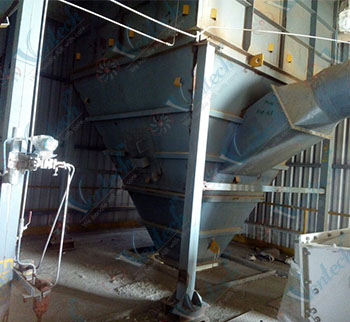
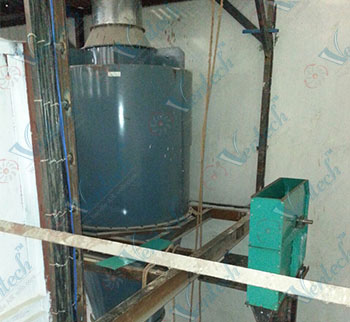
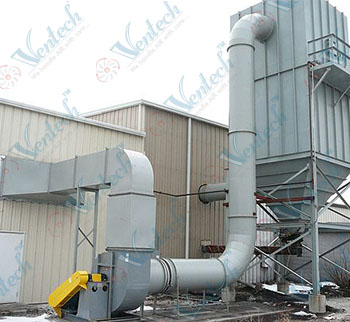
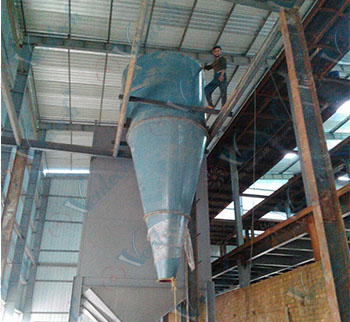
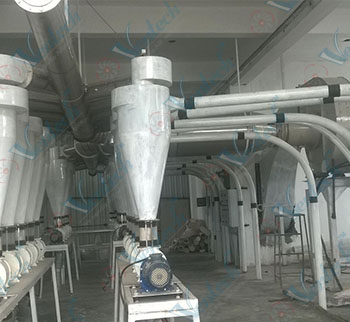
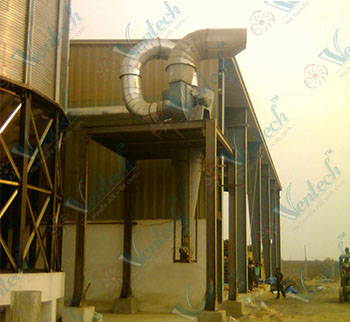
.jpg)
